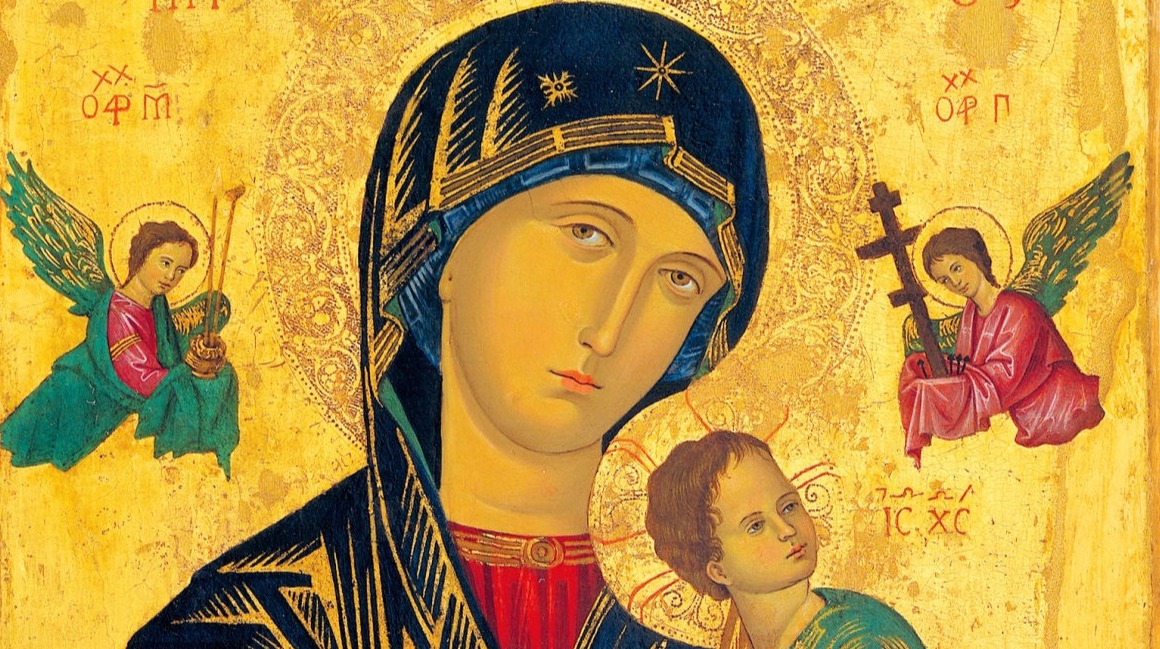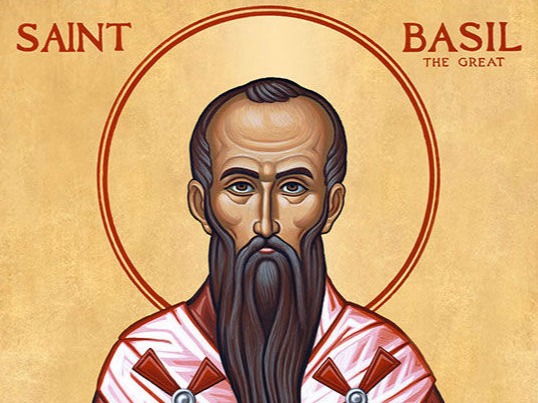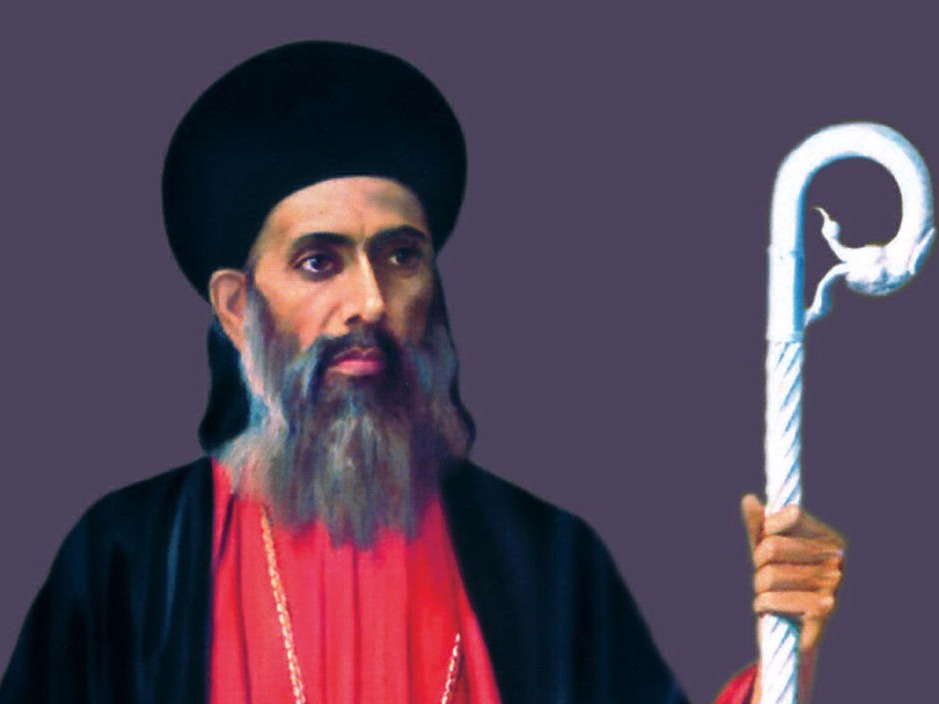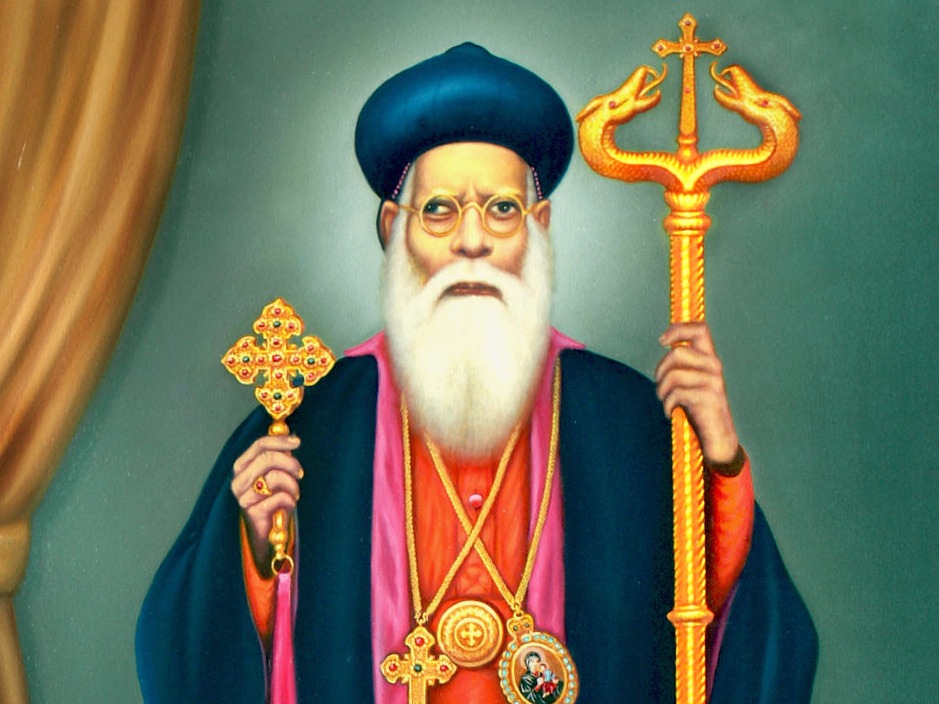
Our Lady Mary, Mother of God
St. Mary is known to be the mediator for all grace and advocate for all the devotees before God. She is the “mother of our Lord” as she was welcomed in this address by Elizabeth the aged mother of St. John the Baptist (St. Luke 1:43).
In our common prayers the Lord’s prayer beginning “Our Father who art in Heaven etc” is generally followed by a repetition of the message of angel Gabriel – St. Luke 1:28- Hail Mary etc and the words of praise of Elizabeth – St. Luke 1:42 – “Blessed are you among women and blessed is the fruit of your words.” We finish it with an appeal for her mediation on our behalf for ever before Almighty even at the moment of our death.
In the sacramental services and prayers of the church from the early periods, the mediation of St. Mary was an integral part. The altars of the churches are sanctified invariably with the name of St. Mary over and above the other saints. Among the three altars of the Karingachira church one is in the name of St. Mary alone, the main altar being St. George’s and the other St. John’s both in association with St. Mary.
In the Syriac Orthodox Churches along with the Holy Mass a textual prayer service in the name of St. Mary is generally conducted at the request of devotees for St. Mary’s intercession. The text for this can be seen in the book of ‘Qurbono Kramam’. It was first published in Syriac by St. Mor Gregorios of Parumala at the behest of Patriarch of Antioch and All the East. According to the teachings of the Church, God is pleased to respond to petitions offered to Him routed through the intercession of St. Mary the Virgin Mother. This was the constant teaching of the holy fathers since the beginning of the Christian church.
Let us go to our Mother. She would point to her son with the message “Do whatever He tells her so you”. (St. John 2:5). She would intercede to her son and our Lord for fulfilling our shortages, well in advance, as it was done during the marriage feast at Cana of Galilee. Be the Mother’s prayer a fort around us for ever Amen.
The words from Virgin Mary:
“While I had him in my womb, I bore him without any pain, without any heaviness or discomfort. I humbled myself in all things, knowing that he whom I bore was the Almighty! When I gave birth to him, it was also without any pain or sin, just as I had conceived him, but with such exaltation and joy of soul and body that my feet did not feel the ground where they had been standing because of this indescribable joy! Just as he had entered my limbs to the joy of all my soul, he left my body, leaving my virginity intact. When I gazed upon and contemplated his beauty, joy seeped through my soul like dewdrops and I knew myself to be unworthy of such a son…”

St. Basil the Great - Our Patron
St. Basil the Great was born at Caesarea of Cappadocia in 330. He was one of ten children of St. Basil the Elder and St. Emmelia. Several of his brothers and sisters are honored among the saints.
He attended school in Caesarea, as well as Constantinople and Athens, where he became acquainted with St. Gregory Nazianzen in 352. A little later, he opened a school of oratory in Caesarea and practiced law. Eventually he decided to become a monk and found a monastery in Pontus which he directed for five years. He wrote a famous monastic rule which has proved the most lasting of those in the East. After founding several other monasteries, he was ordained and, in 370, made bishop of Caesaria. In this post until his death in 379, he continued to be a man of vast learning and constant activity, genuine eloquence and immense charity. This earned for him the title of “Great” during his life and Doctor of the Church after his death. Basil was one of the giants of the early Church. He was responsible for the victory of Nicene orthodoxy over Arianism in the Byzantine East, and the denunciation of Arianism at the Council of Constantinople in 381-82 was in large measure due to his efforts. Basil fought simony, aided the victims of drought and famine, strove for a better clergy, insisted on a rigid clerical discipline, fearlessly denounced evil wherever he detected it, and excommunicated those involved in the widespread prostitution traffic in Cappadocia. He was learned, accomplished in statesmanship, a man of great personal holiness, and one of the great orators of Christianity. His feast day is January 2.

Saint Gregorios of Parumala
Saint Gregorios of Parumala is popularly known as ‘Parumala Thirumeni’. Metropolitan Geevarghese Mar Gregorios of the Malankara Orthodox Church who passed away on November 2nd 1902, became the first declared saint from Malankara (Kerala, India) naturally to be called, ‘Parumala Thirumeni’. He shines in the cloud of witnesses as a bright luminary giving rays of hope to millions in their suffering and struggles.
BIRTH AND PARENTAGE
Mar Gregorios was born on 15th June 1848 (M.E. Mithunam 3, 1023) to Kochu Mathai and Mariam of Pallathetta family in the Chathuruthy house at Mulamthuruthy. He was called by the name ‘Kochaippora’ and was given the baptismal name ‘Geevarghese’. Kochaippora had two brothers and two sisters; Kurian, Eli, Mariam and Varkey. Kochaippora was the youngest and was therefore the most beloved to everyone. Unfortunately, his mother passed away when he was only two years old. His eldest sister Mariam became to him all that a mother was meant. Mariam was married at that time and had a child of Kochaippora’s age.
READER-DEACON AND FURTHER EDUCATION
He was ordained as a reader-deacon (Korooyo) on 14th Sept, 1858 at the age of ten by Palakkunnath Mathews Mar Athanasios at Karingachira Church. Koroyo Geevarghese continued his training under Geevarghese Malpan until the latter died due to small pox. Although Deacon Geevarghese was also infected with small pox, he miraculously survived it. Afterwards Deacon Geevarghese moved to Pampakuda to continued his studies under Konat Geevarghese Malpan. In the mean time Deacon became associated with the visiting Syrian Bishop Yuyakim Mar Coorilos. Mar Coorilos had great admiration for the deacon and was pleased to ordain him as full deacon, priest and cor-episcopa within few months in 1865.
VETTICKAL DAYARA
The new priest’s short stay at Mulanthuruthy Marthommen Church gave him an inner conviction that he should lead a hermit’s life in a quieter place. Therefore he shifted his residence to Vettickal Dayara. At Vettickal Dayara, Corepiscopa Geevarghese started a strenuous life of prayer and fasting. Having heard about the vigorous asceticism practised by corepiscopa Geevarghese, the then Malankara Metropolitan Pulikkottil Joseph Mar Dionysius made him a ‘Ramban’ (Monk Priest) in 1872.
PATRIARCHAL VISIT AND THE SYNOD OF MULAMTHURUTHY
In 1875, the Antioch Patriarch His Holiness Peter III visited Malankara. The Patriarch chose Ramban Geevarghese as his Secretary and translator during the entire visit. Along with the Patriarch , the Ramban visited many churches. Ramban Geevarghese also assisted the Patriarch in the consecration of the Holy Mooron and in the historic synod of Mulanthuruthy in 1876.
CONSECRATION AS METROPOLITAN
Being pleased with the Ramban Geevarghese, the Patriarch decided to consecrate him as Metropolitan. On December 10, 1876 the Patriarch consecrated six priests as bishops including Ramban Geevarghese at St. Thomas Church, N Paravur. He was given the new name Geevarghese Mar Gregorios and was given the charge of Niranam Diocese. The other bishops and their Diocese were:
- Murimattath Mar Ivanios (Kandanad)
- Kadavil Mar Athanasios (Kottayam)
- Ambattu Mar Coorilos (Ankamaly)
- Karottuveetil Simon Mar Dionysius (Cochin)
- Konat Mar Julius (Thumpamon)
- St.Thomas Church, N Paravur
Mar Gregorios was only 28 years when he was made a bishop. Since he was the youngest among all the bishops, he was dearly called by all as ‘Kochu Thirumeni’. The first thing the new bishops undertook was a special fasting-vigil for forty days at Vettickal Dayara under the leadership of ‘Kochu Thirumeni’. This fasting was both symbolic and effective in the pursuit of new life in an old church.
Mar Gregorios took charge of the Niranam Diocese and started staying at Parumala. There was at Parumala, at that time, a land donated by Arikupurath Koruth Mathen to the church and in this plot a small building was erected by the Malankara Metropolitan Pulikkottil Joseph Mar Dionysius. This building was known as ‘Azhippura’. Mar Gregorios lived there along with few other deacons who came for priestly training. They worshipped in a thatched chapel during that time.
THREEFOLD ACTIVITY
Mar Gregorios engaged in a threefold activity of tireless service for the church: Diocesan administration, Ministerial formation of deacons, Missionary witness of the church through inner spiritual and theological consolidation, along with evangelical reaching out.
In addition to these, Mar Gregorios undertook the task of building a church and seminary at Parumala. The diocesan administration, in the mean time, was extended to two more dioceses, Thumpamon and Quilon. The newly constructed church was consecrated in 1895. Mar Gregorios was the co-celebrant for the consecration of two ex-Roman Catholic priests as bishops: Fr.Alvaris as Alvaris Mar Kulius for Bombay-Mangalore Diocese; Fr.Rene Vilatti as Rene Vilatti Mar Timotheos for America.
HOLY LAND – PILGRIMAGE
Mar Gregorios made the Holy Land Pilgrimage in 1895 as the fulfillment of a long cherished dream. On his return he published a travelogue under the title ‘Oorslem yathra vivaranam’ (a narrative of the Jerusalem visit). This book, published in 1895 is to be considered as the earliest printed travelogue in Malayalam. This book had its centenary edition in 1996 and translation into English in 2000.
A VISION AND MISSION FOR THE ENTIRE CHURCH
Mar Gregorios believed that the church should engage in educational activity especially to facilitate primary education and English teaching without discriminating gender or religion. Accordingly he started schools at Kunnamkulam, Mulamthuruthy, Niranam, Thumpamon, Thiruvalla etc. The missionary task of the Church was also evinced by his outreach programme to the socially down trodden communities at Chennithala, Kalikunnu, Mallappally, Puthupally, Kallumkathara etc. He also organized evangelical awakening programme for non-Christians at various places like Aluva, under the leadership of the Seminary students.
A major task of Mar Gregorios was to motivate the clergy for effective ministry. With this aim, he formed the Malankara Syrian Clergy Association and took many progressive decisions and made many suggestions for the effective functioning of the priestly ministry.
DISCIPLES OF THIRUMENI
Among the many disciples of Mar Gregorios, three deserve special notice:
1. Vattasseril Rev.Fr.Geevarghese (later, Malankara Metropolitan Geevarghese Mar Dionysius)
2. Kuttikattu Rev.Fr.Paulose (later, Paulose Mar Athanasios of Aluva)
3. Kallasseril Rev.Fr,Geevarghese (Punnoose) (later, Catholicos Baselios Geevarghese II)
DEPARTURE FROM THE WORLD
Mar Gregorios was already a piles-patient. It became chronic in 1902. Treatments proved futile and slowly His Grace became physically weaker and weaker. At last the blessed soul left the earthly abode on 2nd November 1902. The funeral was conducted at Parumala on Tuesday the 3rd of November 1902 in the presence of thousands of people and hundreds of priests. The many testimonies to the saintly intercession of Mar Gregorios made Parumala Church and the tomb a centre of pilgrimage. In 1947 Mar Gregorios of blessed memory was declared a saint by the then Catholicos of the church, His Holiness Baselius Geevarghese II.
For more details visit: http://www.parumalachurch.org/

Vattasseril Geevarghese Mar Dionysius
The Metropolitan, Vattasseril Geevarghese Mar Dionysius was the beacon of Malankara Church. He had held up freedom as his birthright. His life story enrolls before us the saga of his sacrifices and long-standing devotion to Christianity. He has achieved immortality through the establishment of the Catholicos.
Geevarghese was born on 1858 October 31st in the Vattasseril family in Pauvathikunnel, Mallappally as the son of Joseph and Aleyamma. He learnt the basic lessons from Kottuvalanji Chacko Asan. After completing his studies at the C.M.S. High School, Kottayam, he joined the Vettical Dayara. He had been impressed by the magnetic personality and enlightening speech of Parumala Thirumeni.
Geevarghese achieved proficiency in Syriac and Church history. He became Dean in 1879 and Priest in January 18th, 1880. He received the title of Ramban on 2nd November 1903 from Pulikkottil Joseph Mar Dionysius Metropolitan. Vattasseril Thirumeni performed mentions service to the church as the Malpan of the Old Seminary, as the principles of M.D .Seminary and as the Manager of Parumala Seminary. His monumental work “Mathopadesa Sarangal” (The Essence of Religious Advice) is the collection of the brief notes that he had prepared for teaching his students at these seminaries. It is an authoritative work in which the faith and customs of the Malankara Church are explained on the basis of the Bible. It is a very clear proof the Metropolitan mastery of the Syriac. Church history and Canonical ideas. The intensity of faith that the Metropolitan had intended from his Guru and had purified through meditation always stood in good stead. In moments of crisis this deep faith in the Almighty defended the church. He had also written the work, ‘The Suriani Text Book”.
The Vattasseril Ramban was ordained as Metropolitan on 3rd May 1908 at Jerusalem. On his return to Kerala he engaged himself in Church affairs and acted as the assistant of Joseph Mar Dionysius. On His demise Vattasseril became the Metropolitan of the Malankara Sabha in 1909.
1910 was a problematic year in the history of the Malankara Church. Vattasseril was isolated in the midst of the other Metropolitans who were willing to abandon their faith for the sake of power. He did not fall a prey to the persuasions of the Patriarch Abdulla but stood firmly for the freedom of the church. In 1911 the Patriarch tried to silence the Vattasseril Thirumeni by suspending him. But the church could not accept the suspensions as it was not canonical. In 1912 Ahathulla Bava came here from Antioch and removed the suspension. With this Catholicos came into effect in Malankara. This was the golden dawn of freedom for the true believers of this country. Till then they had been disturbed by the indolence of native church officials and the implementation of power by foreigners.
Many Movements have taken shape from the foresight of Vattasseril Thirumeni. The Students Movement and the Vanitha Samajam are examples of this. Through the Students Movement he encouraged the personality development of students which would enable them to take up responsibilities in life. He could mould the character and workmanship of young men and women. He advised them to retain this principles and philosophy of life at all odds. The aim of the Vanitha Samajam was to bring women from the backyards of then homes to the mainstream of society.
The Metropolitan reminded the people that woman in the centre of the family. Every family can attain education and purity mainly through women. He tried to uplift the backward classes through the activities of the ‘Sleeba Dasa Samooham”.
Another great achievement of the Thirumeni was the conversion of the system of worship into Malayalam. Vattasseril Geevarghese Mar Dionysius was the modern Mosses who could lead the church forward in the changing times. He passed away on 23 February 1934.
The Metropolitan was entombed in the Old Seminary Chapel at Kottayam.